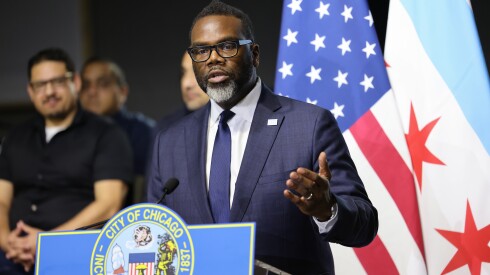Chicago Public Schools put a $100 million price tag Tuesday on Mayor Rahm Emanuel’s sudden mandate to air-condition classrooms in 206 schools, even as CPS faces a $1 billion shortfall and many other pressing capital needs.
Joel Hood, CPS spokesman, said Tuesday the district estimates spending $20 million per year out of the capital budget over five years to fulfill the mayor’s order to cool classrooms with window units.
He did not yet know which schools would be first in line, or how they’d been chosen.
“Adequate air conditioning in a school is a health and safety issue as far as we’re concerned,” Hood said.
“It may not have been mentioned in the five-year plan,” he continued, referring to CPS’ plan for capital spending between 2014 and 2019, which does not prioritize air conditioning but focuses limited capital money on protecting the health and safety of people in school buildings.
Of CPS’ 530 school buildings, 324 are fully air conditioned, 44 have no air conditioning and 162 are partially air conditioned, according to the mayor’s office. Last summer, the district spent $18.7 million to add about 2,400 window units to the 49 buildings designated to take in kids from a record number of shuttered schools, Hood said,. Units also were added in another 21 schools, but the cost for those schools could not be immediately determined. CPS has yet to release its budget proposals for the fiscal year that starts July 1.
Ravenswood Elementary School, housed in the oldest school building in Chicago, raised money from parents to put window units in just two preschool classrooms, said Principal Nate Manaen, who was thrilled Tuesday to hear about eventual salvation from the heat.
“We’ve clocked it in at over 100 degrees at the beginning of the school year and the end of the school year,” Manaen said of the tall brick building. “You can imagine how that affects teaching and learning.”
When the Chicago Teachers Union asked for classroom air conditioning during the negotiations that led to their 2012 strike, the mayor responded with trademark sarcasm, saying, “Everything here is down to two final issues, and it’s not air conditioning, OK? …We don’t go on strike for air conditioning.”
The change in course wasn’t lost on the teachers.
“We were told it wasn’t possible to get, it was cost prohibitive. They couldn’t promise us and we would create a committee to discuss it. That committee hasn’t met. We never discussed it,” CTU vice president Jesse Sharkey said.
“It leaves someone mystified about what there’s resources for and what there aren’t resources for and when the Board is telling the truth about, ‘There’s no money,’ ” Sharkey added. “There’s money for some things.”
Chicago aldermen were taken aback by the mayor’s plan, just as they were when Emanuel unveiled plans to build new schools and school additions so soon after closing 50 schools. Once again, the mayor’s office provided no details to them about the overall price tag or about which other school capital projects might be sacrificed to make way for air conditioning.
“I’m glad they’re finally breaking down,” said Ald. Scott Waguespack (32nd). “But it’s unfortunate that it took three years for him to come around. I find it ironic that it’s campaign season and the mayor is finally figuring out that kids need air conditioning. The kids have deserved it for a lot longer than he’s fought against it.”
Waguespack noted that parents in his ward have also held fundraisers to cool classrooms.
“Companies have wanted to donate air conditioners, and CPS denied them,” Waguespack said. “They said either they were gonna do it or it wasn’t feasible for schools to do it.”
Ald. Latasha Thomas (17th), chairman of the City Council’s Education Committee, defended the decision, saying capital spending is separate from what’s spent to hire teachers and run schools.
“There’s the classrooms. There’s the educators. There’s the buildings. And there are capital needs. They need to prioritize the capital needs out of that pocket of money. And then we need to make sure we have teachers and enough to teach our students and not have 40 students in the classroom. That’s the bigger issue and that’s a different pocket of money.”
Ald. Pat Dowell (3rd) said she used money generated from a surrounding tax-increment-financing district to install air conditioners at Dewey and Woodson elementary schools in her South Side ward.
“Children need to be in an environment where they can learn and not have to worry about how hot it is in their classrooms. So the goal is a worthy goal,” Dowell said.
“In my case, I have helped to fund some of that through tax increment financing money. I’ve got schools in TIF districts. You have to be creative in how you approach funding. I don’t think it’s a cookie-cutter, blanket funding scenario. Some schools are in TIF districts. Some schools are not.”
Ald. Matt O’Shea (19th) considered other priorities for schools in his ward.
“I don’t know if it’s at the top of the list. I certainly want to see more computers in classrooms, more smart boards in classrooms. If it’s not gonna come at the cost of not moving quickly on that, it’s something we should look at.”
Schools in Ald. Nick Sposato’s (36th) Northwest Side ward were so devastated by budget cuts last fall, the alderman spearheaded a drive for toilet paper donations.
Sposato found no particular irony in the mayor’s plan to install air conditioning in schools that couldn’t afford such basics.
“Kids need an atmosphere that’s conducive to learning. Air conditioning in classrooms is something I’m supportive of, but at what cost? How many brutal days do they really have? Is it five or six or is it 25? I would say it’s more like five or six.”




